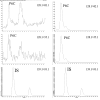The measurement of urinary Δ¹-piperideine-6-carboxylate, the alter ego of α-aminoadipic semialdehyde, in Antiquitin deficiency
- PMID: 22249334
- PMCID: PMC3432202
- DOI: 10.1007/s10545-011-9443-0
The measurement of urinary Δ¹-piperideine-6-carboxylate, the alter ego of α-aminoadipic semialdehyde, in Antiquitin deficiency
Abstract
The assessment of urinary α-aminoadipic semialdehyde (α-AASA) has become the diagnostic laboratory test for pyridoxine dependent seizures (PDS). α-AASA is in spontaneous equilibrium with its cyclic form Δ(1)-piperideine-6-carboxylate (P6C); a molecule with a heterocyclic ring structure. Ongoing diagnostic screening and monitoring revealed that in some individuals with milder ALDH7A1 variants, and patients co-treated with a lysine restricted diet, α-AASA was only modestly increased. This prompted us to investigate the diagnostic power and added value of the assessment of urinary P6C compared to α-AASA. Urine samples were diluted to a creatinine content of 0.1 mmol/L, followed by the addition of 0.01 nmol [(2)H(9)]pipecolic acid as internal standard (IS) and 5 μL was injected onto a Waters C(18) T3 HPLC column. Chromatography was performed using water/methanol 97/3 (v/v) including 0.03 % formic acid by volume with a flow rate of 150 μL/min and detection was accomplished in the multiple reaction monitoring mode: P6C m/z 128.1 > 82.1; [(2)H(9)]pipecolic acid m/z 139.1 > 93.1. Due to the dualistic nature of α-AASA/P6C, and the lack of a proper internal standard, the method is semi quantitative. The intra-assay CVs (n = 10) for two urine samples of proven PDS patients with only modest P6C increases were 4.7% and 8.1%, whereas their inter-assay CVs (n = 10) were 16 and 18% respectively. In all 40 urine samples from 35 individuals with proven PDS, we detected increased levels of P6C. Therefore, we conclude that the diagnostic power of the assessments of urinary P6C and α-AASA is comparable.
Figures






References
-
- Baxter P. Pyridoxine dependent/responsive seizures. In: Baxter P, editor. Vitamin responsive conditions in paediatric neurology. London: Mac Keith Press; 2001. pp. 109–165.
-
- Hunt AD, Stokes J, McCrory WW, et al. Pyridoxine dependency: report of a case of intractable convulsions in an infant controlled by pyridoxine. Pediatrics. 1954;13:140–145. - PubMed
MeSH terms
Substances
Supplementary concepts
LinkOut - more resources
Full Text Sources
Other Literature Sources
Medical
Molecular Biology Databases
Miscellaneous

